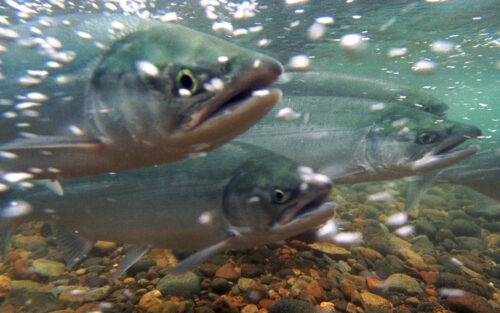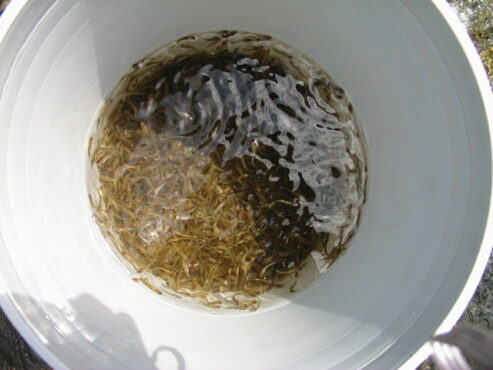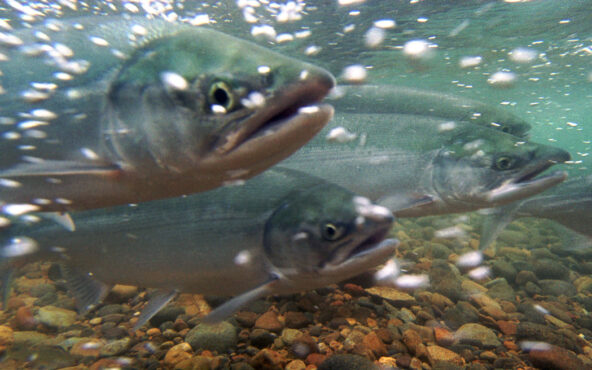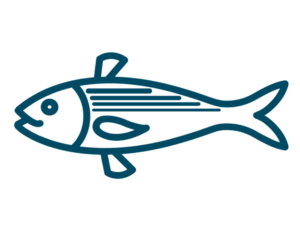Overview
Atlantic salmon (salmo salar) are an anadromous species that spend the majority of their adult lives at sea, only returning to freshwater to spawn. They can grow to over two feet long and weigh about 8 pounds when they return from the Atlantic to spawn for the first time. Born in freshwater rivers, they spend the first two years of their lives growing and feeding there. This coldwater species then heads to the sea to spend several years feeding off the Greenland coast before returning to the freshwater rivers of their birth to spawn. The Connecticut River strain of Atlantic salmon became extinct in the early 1800’s. In 1967 an effort to create a new strain of migratory salmon on the Connecticut began. In 2012, the multi-agency effort to restore sea run Atlantic Salmon to the basin was ended by the Connecticut River Atlantic Salmon Commission (CRASC). Greatly reduced marine survival rates, occuring since the 1990s, and largely attributed to climate change effects, was the primary driver for halting restoration efforts. The State of Connecticut maintains a Salmon Legacy Program that include limited fry stocking and results in a few individual adult returns in some years in the Farmington or Salmon Rivers.
Fish Facts
- Species type Anadromous
- Size 2+ feet
-
Conservation
High Concern
A species of high concern is one that has been evaluated to be at risk of extinction or elimination fie to restricted range, few populations or occurrences, recent and widespread declines, severe threats or other factors.
- Migration period April – June
- Where to see them n/a
River population trends
Fun fact!
Their ability to leap over waterfalls is legendary and reflected in their scientific name (salar means “the leaper”).
What do they look like?
The distinguishing features of the Atlantic salmon are the short face of the fish and the length of the mouth. Atlantic salmon have large black spots on their gill covers and may or may not have spots on their tail fins. They have a forked tail and a body that narrows just before the tail.
Where and when can I see them?
Historically, the Atlantic salmon passed the following dams:
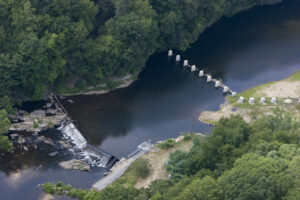
Leesville Dam
About the facility
The Leesville Dam was built on the Salmon River in 1900. It 450 feet wide and 25 ft tall. In 1981 some of the first salmon returns were observed at the Leesville Dam. The fish ladder operation is monitored by the Connecticut Department of Energy and Environmental Protection (CT DEEP), which issues weekly fish count reports during the fish run season.
Who passes through this dam?
When do fish migrate?
Upstream
How are they moving?
At the Leesville Dam, fish move upstream by using the fish ladder. With stepped pools of flowing water, fish can hop up the stepped pools from the base of the barrier to the waters behind. To move downstream, fish at this site go over the dam spillway.
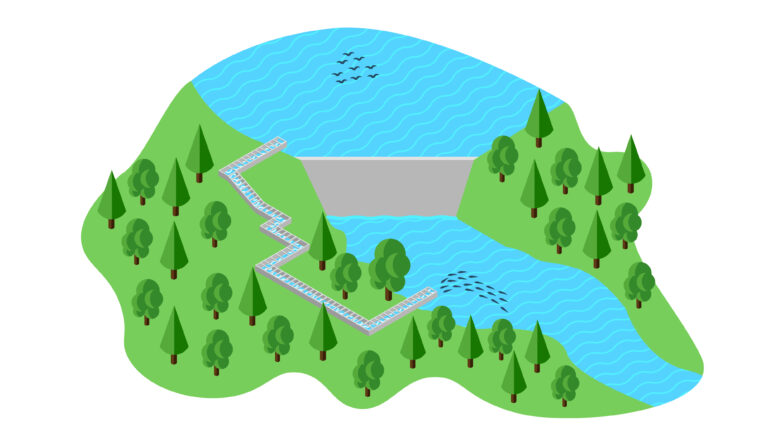
Where and when can I see them?
The Leesville Dam fish ladder does not have specific viewing hours. When in operation, the public can view fish using the ladder by visiting the dam. There is no cost of admission. The fish ladder is located at the following address:
Leesville Dam
Moodus, CT 06469

Rainbow Dam
About the facility
Dams along the Farmington River have been using the rivers power to generate electricity since the early 1800s. The current fish ladder at the Rainbow Dam, which consists of a series of 59 interconnected pools, was constructed in 1976 to make it possible for anadromous fish to return upriver to spawn. A new fish passageway for Rainbow is currently in the design stage.
In 2023, CT DEEP did not operate the Rainbow Fish Ladder due its documented poor performance and the lack of suitable downstream fish passage protection measures at the Stanley Works owned dam/project. Fish passage at this project has been the responsibility of the CTDEEP, due to FERC legal rulings and timing of that facilities construction.
Who passes through this dam?
When do fish migrate?
Upstream
Downstream
How are they moving?
At the Rainbow Dam, fish move upstream using several methods. Many pass upstream by using the fish ladder. With stepped pools of flowing water, fish can hop up the ladder from the base of the barrier to the waters behind. At this site there is also an eel ladder. The eel wrap around the pegs as they move upward. Unlike the fish ladder, the eel ladder does not span the height of the dam. The eel drop into a bucket after traversing the ladder and are deposited above the dam by fishway staff. To move downstream, fish at this site either go over the dam spillway or through a bypass around the dam.
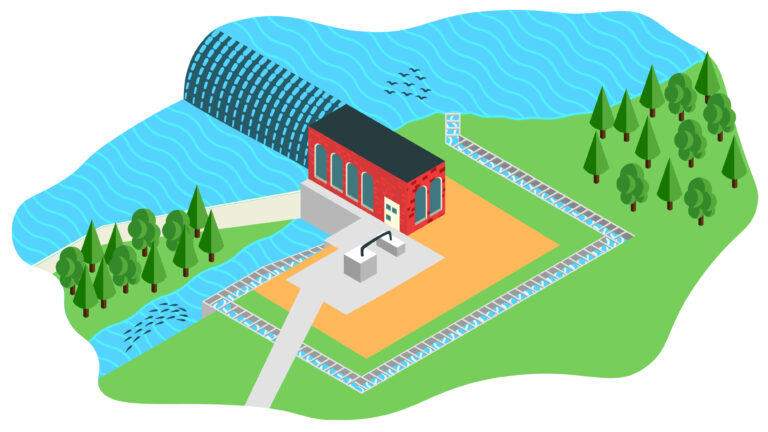
Where and when can I see them?
The fish ladder at Rainbow Dam is open to the public during the migration season on open house days. The outdoor portion of the ladder is open year-round, but the indoor viewing station is only open during open houses. The fish ladder is located at the following address:
Rainbow Dam
Windsor, CT 06095

Holyoke Dam
About the facility
The Holyoke Dam is a granite dam that spans the Connecticut River between Holyoke and South Hadley and diverts water from the river into the Holyoke Canal System and Holyoke Gas & Electric’s (HG&E) Hadley Falls Facility. The dam that you see today was constructed between 1895 and 1900. The Hadley Falls Facility is located on the Holyoke side of the Holyoke Dam and contains two hydroelectric generating wheels with a total installed capacity of approximately 33 megawatts. Hadley Falls also houses a fish lift to help fish traveling upstream pass over the dam, and is open to the public for Fishway viewing and tours during the public viewing season.
Who passes through this dam?
When do fish migrate?
Upstream
Downstream
How are they moving?
At the Holyoke Dam, fish move upstream primarily using a fish elevator. With this elevator, fish swim into a collection area at the base of the dam. When enough fish enter the collection area, they are moved into a hopper that carries them toa flume that empties above the dam. At the Holyoke Dam, two elevators lift 500 fish at a time up the 52 foot dam. At this site there is also an eel ladder. The eel wrap around the pegs as they move upward. Unlike the fish ladder, the eel ladder does not span the height of the dam. The eel drop into a bucket after traversing the ladder and are deposited above the dam by fishway staff. To move downstream, fish at this site either go over the dam spillway or through a bypass around the dam.

Where and when can I see them?
The Robert Barret Fishway at the Holyoke Dam is open to the public during the migration season, but visitors must reach out via their online form to request a tour. The fish ladder is located at the following address:
Robert Barrett Fishway
1-3 County Bridge
Holyoke, MA 01040
Tel: (413) 536-9460
Email the Fishway
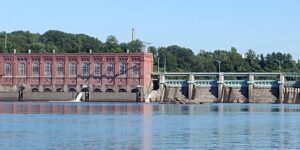
Vernon Dam
About the facility
The Vernon Dam was built in 1909, and its primary use is to generate hydropower by harnessing the power of the river. The fish ladder at the Vernon Dam became operational in 1981 and provided upstream access for migratory fish. The dam is owned and operated by Great River Hydro. The fish ladder at Vernon Dam is to the left of the powerhouse.
Who passes through this dam?
When do fish migrate?
Upstream
Downstream
How are they moving?
At the Vernon Dam, fish move upstream by using the fish ladder. With stepped pools of flowing water, fish can hop up the ladder from the base of the barrier to the waters behind. At this site there is also an eel ladder. The eel wrap around the pegs as they move upward. Unlike the fish ladder, the eel ladder does not span the height of the dam. The eel drop into a bucket after traversing the ladder and are deposited above the dam by fishway staff. To move downstream, fish at this site either go over the dam spillway or through a bypass pipe around the dam.
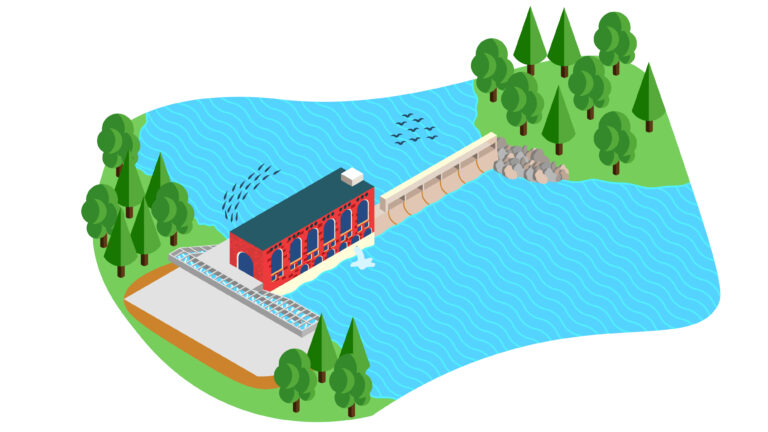
When and where can I see them?
The outside viewing platform at the Vernon Dam fish ladder is open to the public during migratory fish season. There is no indoor viewing open to the public. Local organizations and companies sometimes run tours at the fishway. The fish ladder is located at the following address:
Vernon Dam
110 Governor Hunt Rd
Vernon, VT 05354

Bellows Falls Dam
About the facility
In the 1920s, the present concrete dam and hydroelectric powerhouse were constructed in Bellows Falls, VT. The fish ladder was completed in 1982 in an effort to reintroduce migratory fish species to the reaches of the upper Connecticut River and its tributaries. The dam is owned and operated by Great River Hydro. Just above the powerhouse is a visitor’s center with information about fish migration and local history.
Who passes through this dam?
When do fish migrate?
Upstream
Downstream
How are they moving?
At the Bellows Falls Dam, fish move upstream by using the fish ladder. With stepped pools of flowing water, fish can hop up the stepped pools from the base of the barrier to the waters behind.
To move downstream, fish at this site either go over the dam spillway or through a bypass around the dam.

Where and when can I see them?
The fishway at the Bellows Falls Dam is open to the public during migratory fish season. Bellows Falls Dam has a visitors center with information about fish migration and a viewing window and platform. To contact via phone, call the direct line to the center during the open season on open days from 10:00AM – 4:00PM at 802-460-4664.
17 Bridge St
Bellows Falls, VT 05101
